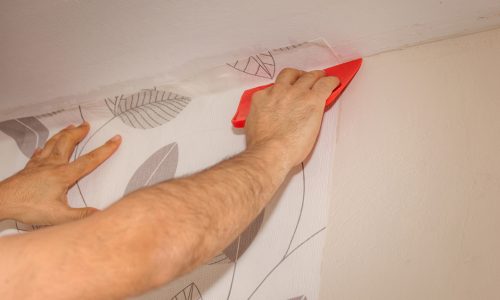Unknown Facts About 14 Essential Wallpaper Tools For Flawless Installations
Overlap and cut both pieces at when, Cut down the middle of the overlap, Lap one panel over the other, and lower the middle of the overlap. Angle the knife blade down low so more than just the idea of the blade is doing the cutting. Often, instead of butting one panel up to another, you'll need to develop your own joint.
Bob chooses a 10-in. knife so he doesn't need to move it as often as he would a smaller sized one. Hold the knife down close to the wall to prevent cutting into the ceiling. Make relief cuts prior to trimming, Use a scissors for relief cuts, Utilize a scissors rather of a knife to prevent accidentally cutting into wood trim and other barriers.

Job information Skill 3 out of 5 Moderate Not so bad for somebody with perseverance and precision, which are crucial to hanging paper directly, plumb, and perfectly lined up. Wallpaper first appeared in the 16th century, in the kind of black-and-white hand-blocked prints, and it remains a preferred method to bring color, texture, and character to a home.
The 6-Second Trick For A Woman's Touch Paint And Paper: Interior Painting Services ...
According to John Dee, these are much easier to work with than more fragile and tear-prone plain paper, and generally come pre-pasted, getting rid of the requirement to roll on starch-based adhesives. They can, nevertheless, be more difficult to cut and need bonding with vinyl-to-vinyl adhesive. Pointer: Silk, grass, fabric, and textured documents also need mindful attention during installation: "You absolutely can't get paste on their faces," Dee says.

Step the width and height of this wall and mark its midpoint. Cut a brief strip of wallpaper. wallpaper installers near me. Location the dominant element over the midpoint. Mark the wall at the paper's leading edge, the edge against which the next strip will hang. Utilizing a 4-foot level, draw a plumb line at that mark.
To offer the adhesive a chance to activate, gently fold over both ends of the strip, bewaring not to crease the paper, so that they meet in the middle; this process is referred to as "reservation." Make certain the paper's edges are exactly lined up so that no pasted surface is exposed (wallpaper hangers).
Getting The How To Hang Wallpaper In 9 Steps - Residential Painting.Contractors To Work
For pre-pasted paper, loosely roll up a strip with the adhesive side out and immerse it in a trough of cold to lukewarm water, depending on the manufacturer's directions, just until the paper is completely wet (but no longer). Book the paper as above for 3 to 5 minutes. Step 4: Hang the First Strip Take the reserved strip to the wall, then unfold and apply the leading half, lining up one edge with the plumb line in Step 2.
Overlap a patterned paper as required so that the primary style element is fixated the midpoint of the wall section. First, smooth the edges of the paper with a moist sponge, then brush gently from the center of the strip to its edges. Next, gently pull (do not push) a smoother throughout the paper to get rid of wrinkles and anchor the paper to the wall.
Procedure, cut, and hang each subsequent strip, moving them up or down on the wall to align the pattern and to butt joints securely without any overlaps. Action 6: Wallpaper the Corners Corners are the only locations where strips overlap. For a within corner, step from the corner to the top, middle, and bottom of the last-pasted strip.
The How To Hang Wallpaper Using The Proper Wallcovering Tools Statements
Using a level, trim a dry strip to that width, cutting the edge that'll satisfy the corner. Hang the paper so the just-cut edge turns the corner and extends onto the surrounding wall. Position the adjoining strip with its edge inside the corner, overlapping the previous strip; line up the patterns.

Using the line as a guide, hang this strip. For outdoors corners, trim the strip to wrap over the next wall by inch. Hang the next strip so it overlaps the previous piece but lands short of the corner. This avoids the paper from peeling if someone brushes versus the corner.
From the paper's waste edge to the corners of the trim, make diagonal cuts with scissors to enable the paper to lay flat on the wall. Remove the bulk of the overlap with scissors. Smooth the paper as in Step 4, then utilize the smoother to push the paper comfortably versus the case, the ceiling, and the baseboard.
Not known Facts About Phillip Jeffries - The World's Leader In Natural, Textured ...
Step 8: Trim Around Window Apron To cut around a window's stool and apron, make a series of routes from the waste edge of the strip towards the corner where wall and stool fulfill. These narrow fingers of paper enable the strip to be shaped to the profile of the case.
Get detailed directions on how to hang embossed and standard wallpaper - wallpaper hanger.
olympic deck stain reviews